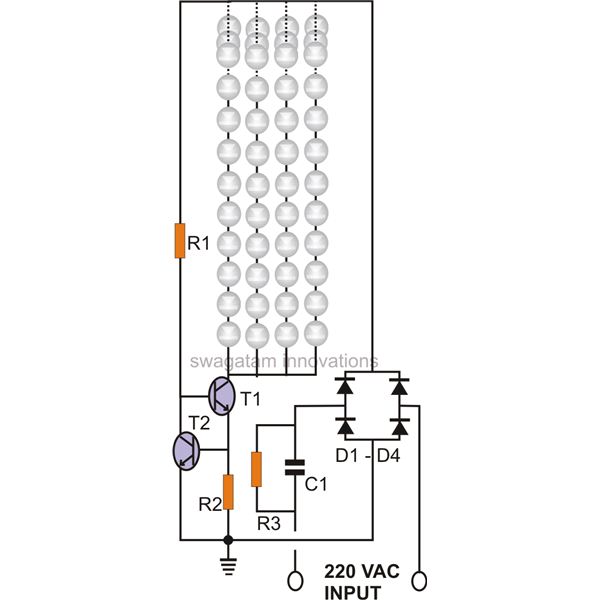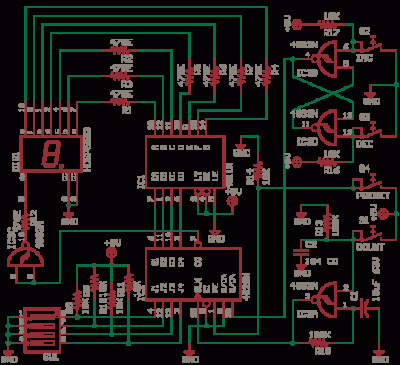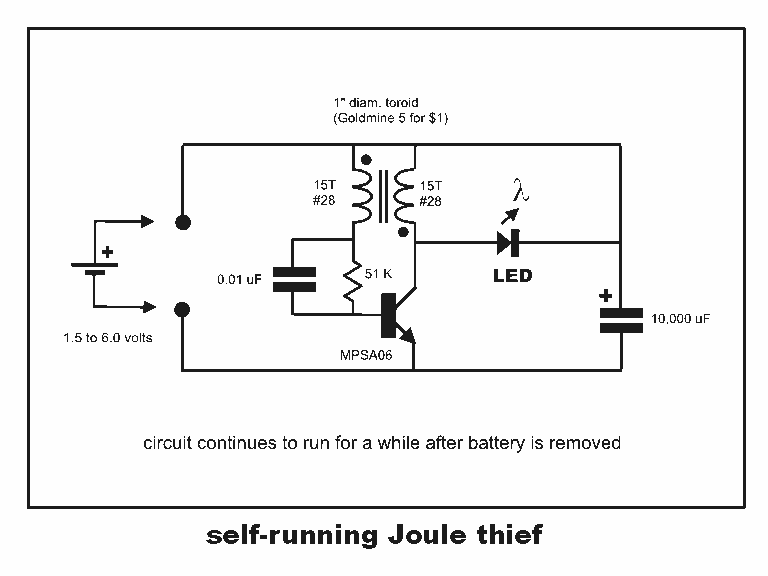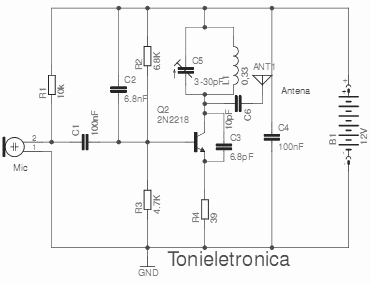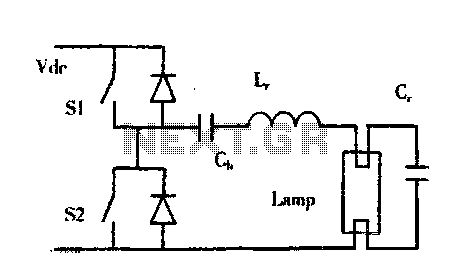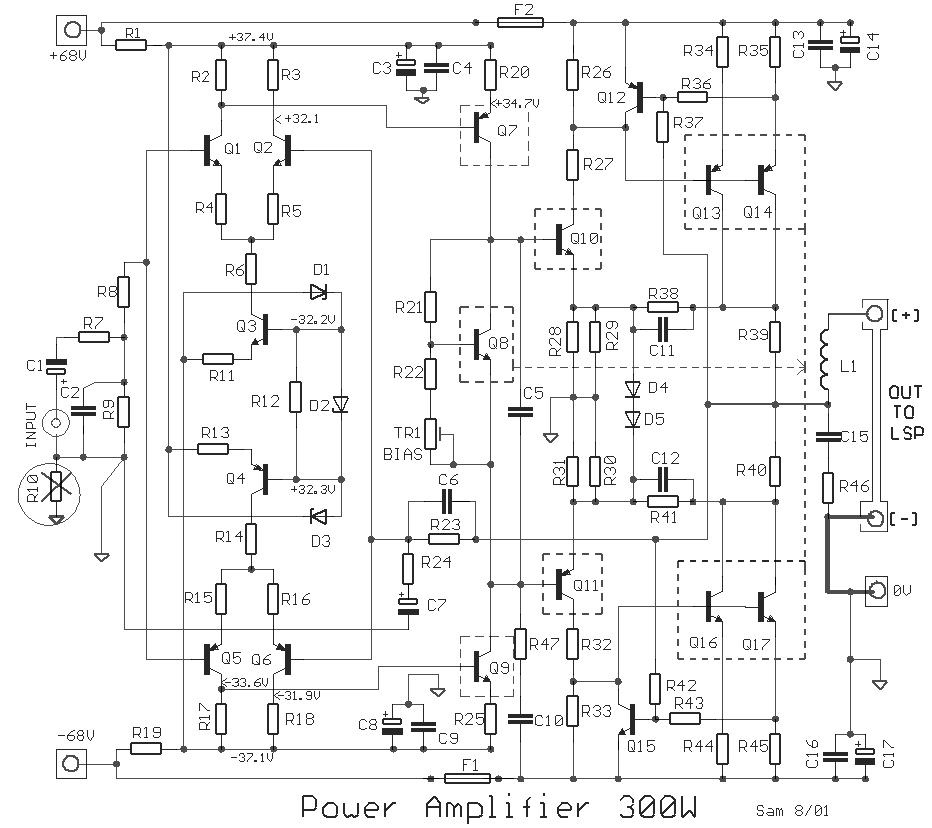
transistors audio controlled relay circuit
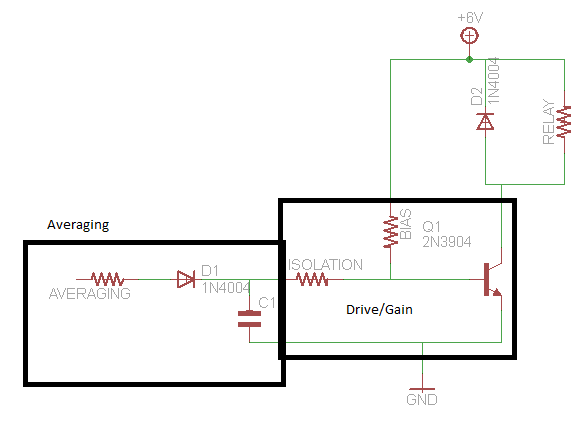
A circuit that activates a relay upon detecting audio pulses from one channel of an MP3 player. The intention is to synchronize recorded audio pulses with music to control a motor for mouth movement. For a stereo player, music or other audio can be mixed onto the left channel, while the right channel should consist of a series of loud sine pulses.
Additional comments suggest that the size and type of motor or actuator intended for use should be clarified, as well as the desired mechanics of movement for the resulting device. It is noted that the value of capacitor C1 may need to be determined experimentally, as it likely depends on the output impedance of the MP3 player. Observing the signal at that point using an oscilloscope is recommended. Additionally, a potential issue arises with the transistor (3904) entering linear operation due to varying input signal levels. For effective relay control, the transistor should be driven to either fully on or fully off states to prevent power loss and ensure reliable relay activation.
This circuit design incorporates an audio detection mechanism that triggers a relay based on the audio signals received from an MP3 player. The left audio channel is dedicated to music, while the right channel generates distinct sine wave pulses, which serve as the control signals for the relay. The relay is used to switch a motor or actuator responsible for mimicking mouth movements, an application that could be useful in robotics or animatronics.
The circuit's core components include a relay, a transistor (specifically a 3904 NPN transistor), and a capacitor (C1). The relay serves as the main output device that will be activated when audio pulses are detected. The transistor acts as a switch, controlling the relay based on the audio signal levels. The capacitor's role is to filter or smooth the audio signal to ensure that only the necessary pulses are detected by the transistor.
To ensure optimal performance, the circuit requires careful consideration of the input signal levels. If the audio signal is too weak or too strong, it may cause the transistor to operate in a linear region, which is undesirable for relay control. Instead, the circuit should be designed to ensure that the transistor is driven into saturation (fully on) or cutoff (fully off) states. This can be achieved by adjusting the values of resistors in the base circuit and experimenting with the capacitor value (C1) to match the output impedance of the MP3 player.
In summary, the circuit is designed to utilize audio signals for relay activation, facilitating the control of a motor for specific mechanical movements. Key considerations include the selection of components, the configuration of the audio channels, and the tuning of the circuit parameters to achieve reliable operation.A circuit that fires a relay when it detects audio pulses from one channel of an mp3 player. I`m going to record audio pulses in sync with the music to control a motor for mouth movement. So for your stereo player, you`ll just mix music/whatever onto (arbitrarily) the left channel and have the right just be a series of loud sine pulses Nick T Oct 2 `10 at 4:14 Hey Pete - could you give us an idea about the kind and size of motor or actuator you intend to use also could you comment a little on the mechanics - maybe just mention how you`d like the resulting thing to move - I just thought it might help people answer your question fully. Jim Oct 2 `10 at 15:14 You probably have to find the value of C1 experimentally. It probably depends on the output impedance of your MP3 player. Look at that point on a scope if you can. endolith Oct 2 `10 at 15:38 The problem you will run into is that there will be input signal levels that will put the 3904 into linear operation.
To control a relay you want the transistor to drop either all the supply voltage or (very nearly) none of it. Intermediate states will just waste power cooking your transistor and won`t necessarily pull the relay in.
JustJeff Oct 5 `10 at 1:43 🔗 External reference
Additional comments suggest that the size and type of motor or actuator intended for use should be clarified, as well as the desired mechanics of movement for the resulting device. It is noted that the value of capacitor C1 may need to be determined experimentally, as it likely depends on the output impedance of the MP3 player. Observing the signal at that point using an oscilloscope is recommended. Additionally, a potential issue arises with the transistor (3904) entering linear operation due to varying input signal levels. For effective relay control, the transistor should be driven to either fully on or fully off states to prevent power loss and ensure reliable relay activation.
This circuit design incorporates an audio detection mechanism that triggers a relay based on the audio signals received from an MP3 player. The left audio channel is dedicated to music, while the right channel generates distinct sine wave pulses, which serve as the control signals for the relay. The relay is used to switch a motor or actuator responsible for mimicking mouth movements, an application that could be useful in robotics or animatronics.
The circuit's core components include a relay, a transistor (specifically a 3904 NPN transistor), and a capacitor (C1). The relay serves as the main output device that will be activated when audio pulses are detected. The transistor acts as a switch, controlling the relay based on the audio signal levels. The capacitor's role is to filter or smooth the audio signal to ensure that only the necessary pulses are detected by the transistor.
To ensure optimal performance, the circuit requires careful consideration of the input signal levels. If the audio signal is too weak or too strong, it may cause the transistor to operate in a linear region, which is undesirable for relay control. Instead, the circuit should be designed to ensure that the transistor is driven into saturation (fully on) or cutoff (fully off) states. This can be achieved by adjusting the values of resistors in the base circuit and experimenting with the capacitor value (C1) to match the output impedance of the MP3 player.
In summary, the circuit is designed to utilize audio signals for relay activation, facilitating the control of a motor for specific mechanical movements. Key considerations include the selection of components, the configuration of the audio channels, and the tuning of the circuit parameters to achieve reliable operation.A circuit that fires a relay when it detects audio pulses from one channel of an mp3 player. I`m going to record audio pulses in sync with the music to control a motor for mouth movement. So for your stereo player, you`ll just mix music/whatever onto (arbitrarily) the left channel and have the right just be a series of loud sine pulses Nick T Oct 2 `10 at 4:14 Hey Pete - could you give us an idea about the kind and size of motor or actuator you intend to use also could you comment a little on the mechanics - maybe just mention how you`d like the resulting thing to move - I just thought it might help people answer your question fully. Jim Oct 2 `10 at 15:14 You probably have to find the value of C1 experimentally. It probably depends on the output impedance of your MP3 player. Look at that point on a scope if you can. endolith Oct 2 `10 at 15:38 The problem you will run into is that there will be input signal levels that will put the 3904 into linear operation.
To control a relay you want the transistor to drop either all the supply voltage or (very nearly) none of it. Intermediate states will just waste power cooking your transistor and won`t necessarily pull the relay in.
JustJeff Oct 5 `10 at 1:43 🔗 External reference
